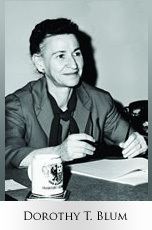Died October 1980 | ||
 | ||
Dorothy Toplitzky Blum (February 21, 1924 – October 1980) was an American computer scientist and cryptanalyst. She worked for the National Security Agency and its predecessors from 1944 until her death in 1980.
Contents
Career
Dorothy Toplitzky was born in 1924 in New York City to Austro-Hungarian immigrant parents. After graduating from Brooklyn College, in 1944 she joined the cryptologic unit of the U.S. Army. When World War II ended, she remained in the organization as it became the United States Army Security Agency and later the National Security Agency (NSA). She married NSA mathematician Joseph Blum in 1950 and they later had a son.
In the 1950s, Blum worked in the NSA's internal organization tasked with "keep[ing] abreast of the latest advances in the field of computing" and recommended computer technologies that could be adapted for cryptanalysis and communications intelligence. She wrote computer software for the NSA and spearheaded the effort to teach NSA employees to write cryptanalytic programs. She was using the Fortran programming language three years before its public release in 1957.
Throughout the 1960s and 1970s, Blum continued to work in the field of computer science, helping to design the NSA's computer systems and automate processes. In 1972, she became the chief of the NSA Computer Operations Organization (C7), the only woman at the time in the organization's management hierarchy. She was appointed chief of Plans and Project Development Organization (T4) in the Telecommunications and Computer Services Organization in 1977. She was also involved in the Women in NSA (WIN) group.
Legacy
Blum died from cancer in October 1980, aged 56. An internal award at the NSA was named after her, and in 2004 she was inducted into the NSA Hall of Honor. An official NSA biography states that, in her 36-year career, Blum "significantly changed the way NSA did cryptanalysis". She was also elected one of the top 100 "most outstanding women in the federal government".
